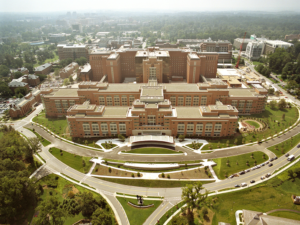By Lilian Nassi-Calò

Image: Wikipédia.
Preprints are complete scientific articles deposited in open access repositories or servers before undergoing peer review. A pre-selection by an editor is done to evaluate the methodological soundness and scientific nature of the article and in about a day the article is available for review and comments by anyone. From the feedback received in the form of comments and criticisms, the authors can modify the manuscript and eventually formally submit it to a journal.
This publication modality is commonly used in Physics since the implementation of arXiv in 1991. More recently, at the ASAPbio Conference in February 2016, the Biology and Life Sciences scientific community endorse and recommend the publication of preprints as a way to speed up the dissemination of research results and improve peer review. BioRxiv, launched in 2013 by the Cold Spring Harbor Laboratories, is gaining increasing importance since ASAPbio and currently holds nearly 10,000 deposited articles.
A news released on March 241, however, should foster this practice even more. The reputed U.S. National Institutes of Health (NIH), a research and development agency linked to the Department of Health, reported that grant proposals and reports submitted to this institution are allowed – and encouraged – to cite preprints. The official announcement entitled “Reporting Preprints and Other Interim Research Products” is available on the grants page at the NIH’s website. The purpose of including preprints, according to the announcement, is to “encourage investigators to use interim research products, such as preprints, to speed the dissemination and enhance the rigor of their work.” Moreover, the text defines preprints as “… typically unreviewed manuscripts written in the style of a peer-reviewed journal article. Scientists issue preprints to speed dissemination, establish priority, obtain feedback, and offset publication bias”.
The reaction to the NIH announcement was extremely positive. Jessica Polka, director of the ASAPbio initiative, stated that it is hard not to overstate the NIH’s new policy. “It will incentivize tens of thousands of applicants and awardees to not only list interim research products on their applications and reports, but also to create them in the first place”.
The NIH establishes clear rules on how to cite preprints, which must include the Digital Object Identifier (DOI) and Object type (preprint, protocol, etc.), as well as the date of the version being cited. See an example below:
Bar DZ, Atkatsh K, Tavarez U, Erdos MR, Gruenbaum Y, Collins FS. Biotinylation by antibody recognition- A novel method for proximity labeling. BioRxiv 069187 [Preprint]. August 11, 2016 [cited 2017 Jan 12]. Available from: https://doi.org/10.1101/069187.
Authors must also be careful when selecting a preprint repository or server. Firstly, it is necessary that the repository abides to a Creative Commons CC-BY license, or that the contents are declared as public domain. In this way, it is possible to ensure that the contents are findable, accessible, interoperable and reusable. Preprint metadata, including usage statistics, should be accessible to both people and machines. It is important that the repository has clear policies on plagiarism, ethical misconduct, and conflicts of interest. If the preprint is published in a journal, the link should also be provided. Finally, the archiving system must be robust and ensure long-term preservation and access to contents.
The NIH decision is expected to be followed by other funding agencies and research institutions around the world, also points out Jessica Polka, of ASAPbio. In this sense, the SciELO Program has already announced the creation and development of a preprints server that will cover various disciplines and subject areas, as well as the journals it indexes. SciELO Preprints is in the process of defining governance and operational structures, and for this, SciELO maintains a close and direct dialogue with the community of editors, authors, and publishers of SciELO journals. It is expected that the operational deployment of SciELO Preprints will occur in mid-2018.
The NIH initiative, however, was not immediately embraced by other entities. The Federation of American Societies for Experimental Biology (FASEB), however, has stated that the NIH announcement does not alter the Federation’s stance on preprints, stating that this issue is still under discussion.
Reactions on social networks, however, were more enthusiastic. Leslie Vosshall, a neurobiologist at Rockefeller University in New York, USA, said: “visionary and important policy change that benefits open science and trainees.” John Didion, a postdoctoral fellow at NIH’s National Human Genome Research Institute, said: “Way overdue, but still awesome!” Clearly, science openness and transparency have much to celebrate!
Note
1. Reporting Preprints and Other Interim Research Products [online]. National Institutes of Health (NIH). 2017 [viewed 15 April 2017]. Available from: http://grants.nih.gov/grants/guide/notice-files/NOT-OD-17-050.html
References
NASSI-CALÒ, L. From the NY Times: Biologists went rogue and publish directly on the Internet [online]. SciELO in Perspective, 2016 [viewed 15 April 2017]. Available from: http://blog.scielo.org/en/2016/04/07/from-the-ny-times-biologists-went-rogue-and-publish-directly-on-the-internet/
PACKER, A.L., SANTOS, S. and MENEGHINI, R. SciELO Preprints on the way [online]. SciELO in Perspective, 2017 [viewed 15 April 2017]. Available from: http://blog.scielo.org/en/2017/02/22/scielo-preprints-on-the-way/
Reporting Preprints and Other Interim Research Products [online]. National Institutes of Health (NIH). 2017 [viewed 15 April 2017]. Available from: http://grants.nih.gov/grants/guide/notice-files/NOT-OD-17-050.html
SPINAK, E. What’s the deal with preprints? [online]. SciELO in Perspective, 2016 [viewed 15 April 2017]. Available from: http://blog.scielo.org/en/2016/11/22/whats-the-deal-with-preprints/
VELTEROP, J. Preprints – the way forward for rapid and open knowledge sharing [online]. SciELO in Perspective, 2017 [viewed 17 May 2017]. Available from: http://blog.scielo.org/en/2017/02/01/preprints-the-way-forward-for-rapid-and-open-knowledge-sharing/
External links
arXiv – https://arxiv.org/
ASAPbio – http://asapbio.org/
bioRxiv – http://biorxiv.org/
NIH – https://www.nih.gov/
 About Lilian Nassi-Calò
About Lilian Nassi-Calò
Lilian Nassi-Calò studied chemistry at Instituto de Química – USP, holds a doctorate in Biochemistry by the same institution and a post-doctorate as an Alexander von Humboldt fellow in Wuerzburg, Germany. After her studies, she was a professor and researcher at IQ-USP. She also worked as an industrial chemist and presently she is Coordinator of Scientific Communication at BIREME/PAHO/WHO and a collaborator of SciELO.
Translated from the original in Portuguese by Lilian Nassi-Calò.
Como citar este post [ISO 690/2010]:







![Funders support use of reviewed preprints in research assessment [Originally published by eLife in December/2022] eLife logo](https://blog.scielo.org/en/wp-content/uploads/sites/2/2022/11/eLife-logo_thumb.jpg)
![Some remarks on peer review and preprints [Originally published as the editorial in Memórias do Instituto Oswaldo Cruz vol. 118] Montage. Photo of a data center, a corridor with machines occupying the wall and processing computer systems. In front, a vector illustration of a microscope and a cross behind. A braided circle around the two. At the top, the logo of the journal Memórias do Instituto Oswaldo Cruz. At the bottom, the text: Peer Review x Preprint.](https://blog.scielo.org/en/wp-content/uploads/sites/2/2023/07/mioc-thumb.png)








Read the comment in Spanish, by Javier Santovenia:
http://blog.scielo.org/es/2017/05/17/las-propuestas-de-financiamiento-de-investigacion-enviadas-al-nih-pueden-citar-preprints/#comment-41023